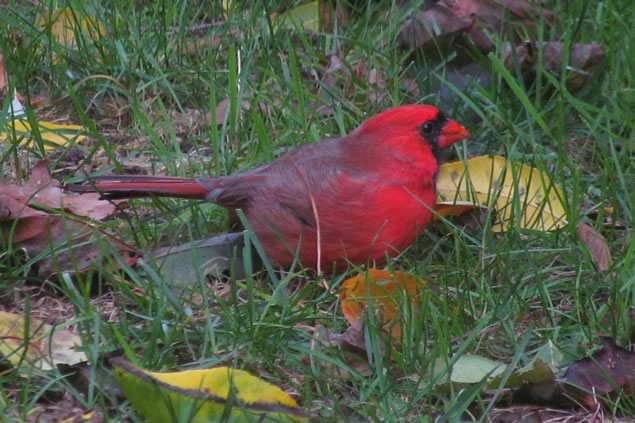Cardinals
Cardinals appear at feeders most frequently at dusk and dawn. Perhaps during the twilight hours they are less visible to predators.
The lovely cardinal is a rather recent arrival to southern Ontario. Nesting cardinals were first discovered in the province in 1901 at Point Pelee. Cardinals probably didn’t become well established in the Headwaters region until the mid-twentieth century or so.
Why this northward expansion? Cardinals are able to thrive in human- altered landscapes. They are “edge” habitat specialists, happiest where woodlands merge with shrubby fields.
In addition, the proliferation of bird feeders has likely played a major role in supporting the expansion of cardinals. Climate warming will probably spur further northward movement.

Cardinals are “edge” habitat specialists, happiest where woodlands merge with shrubby fields. Photo by Don Scallen
Cardinals appear at feeders most frequently at dusk and dawn. Perhaps during the twilight hours they are less visible to predators.
Those predators include northern shrikes. A friend told me about two separate occasions when he observed shrikes feeding on cardinals. Both were males, suggesting the possibility that the brilliance of male cardinals, while alluring to females, may also attract the unwanted attention of predators.
Further support for this theory came during a recent Christmas bird count. I watched a shrike chase a male cardinal over the ice of a pond. There the birds hovered eye to eye and then landed, facing each other in a seeming test of wills.
Soon though, the pursuit was on again. The cardinal flew towards the shelter of pond-side cedars, with the shrike riding its tail feathers all the way.
I was graced with another fascinating glimpse into cardinal existence last August. A brave cardinal ripped a small paper wasp nest off the soffit of my house. It tore the nest apart on a neighbour’s lawn, presumably to feed upon the developing wasp larvae inside!
Our appreciation of cardinals should extend beyond their good looks. Like all creatures they lead complex, fascinating – and sometimes perilous lives.












I was excited to see two beautiful female cardinals on the ground under the bird feeder. I just looked online as I had no idea at first what I was looking at. It’s November and 2pm.
Maralyn Jullienne from Guildwood village, Scarborough, Ontario on Nov 9, 2014 at 2:32 pm |
Hi Maralyn,
So glad you were graced with the female cardinals. A bright red male must have been nearby as well – female cardinals almost always have male company. The females, as you noted, are beautiful – more subtly coloured than the males, but lovely nonetheless. May you continue to enjoy their presence!
Don Scallen
Don Scallen on Nov 12, 2014 at 11:46 am |
I live in Milwaukee, Wisconsin and I too was just graced to watch a Cardinal also pull down a paper wasp nest. First it went up two or three times grabbing pieces (larvae?) Finally it took the entire things in it’s beak and flew away. It didn’t seem at all phased by the few wasps that came out to defend the nest. Very neat to witness!
Sharain Horn on Jun 23, 2012 at 6:56 pm |